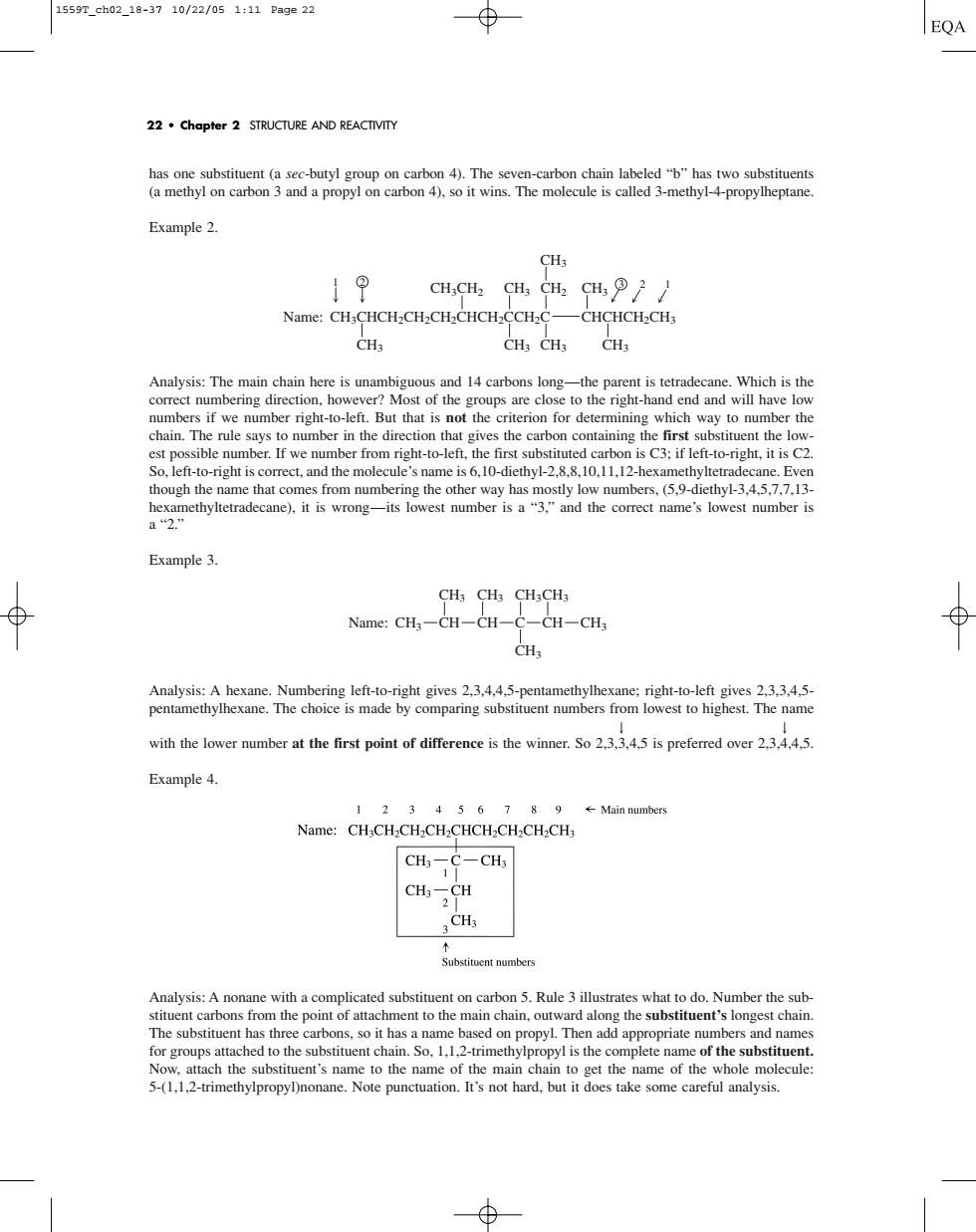正在加载图片...

1559reh0218-3710/22/051:11Page22 EQA 22.chapter 2 STRUCTURE AND REACTIVITY has one substitu propylheptan Example 2. CH3 Name:CH.CHCH.CH.CH.CHCH.CCHC-CHCHCH.CH CHs CH3 CHsCHs Analysis:The main chain he e is unamb and 14carbons ong the numbers if we number right-to-left.But that is not the criterion for determining which way to number the chain.The rule says in the direction t t gives the carbon containing the first t the lo So left-to ctand the molccule's name is6.10-dicthl28810.11.12-hexamethyltetradecane Ever though the name that comes from numbering the other way has mostly low numbers.(59-diethyl-3.4.5.7.7.13- methyltetradecane).it is wrong-its lowest number is a3."and the correct name's lowest number is Example3. CH3 CH3 CHaCH3 Name:CH3-CH-CH-C-CH-CHs h Analysis:A hexane.Numbering left-to-right gives 2.3,4,4.5-pentamethylhexane:right-to-left gives 2.3.3.4.5- pentamethylhexane.The choice is made by comparing substituent numbers from lowest to highest.The name with the lower number at the first point of difference is the winner.So 2.3.3.4.5 is preferred over 2.3.4.4.5. Example 4. 133456780 ←Main numbe Name: CH.CH.CH.CH.CHCH.CH.CH.CH, CH 2CH thon 5 Rule 3 illus The substituent has three carbons.so it has a name based on propyl.Then add appropriate numbe nd name for groups attached to th opy Is t of th 5-(1-rmcthypropyonan.Note punctuation.snot hard but analysis.has one substituent (a sec-butyl group on carbon 4). The seven-carbon chain labeled “b” has two substituents (a methyl on carbon 3 and a propyl on carbon 4), so it wins. The molecule is called 3-methyl-4-propylheptane. Example 2. Analysis: The main chain here is unambiguous and 14 carbons long—the parent is tetradecane. Which is the correct numbering direction, however? Most of the groups are close to the right-hand end and will have low numbers if we number right-to-left. But that is not the criterion for determining which way to number the chain. The rule says to number in the direction that gives the carbon containing the first substituent the lowest possible number. If we number from right-to-left, the first substituted carbon is C3; if left-to-right, it is C2. So, left-to-right is correct, and the molecule’s name is 6,10-diethyl-2,8,8,10,11,12-hexamethyltetradecane. Even though the name that comes from numbering the other way has mostly low numbers, (5,9-diethyl-3,4,5,7,7,13- hexamethyltetradecane), it is wrong—its lowest number is a “3,” and the correct name’s lowest number is a “2.” Example 3. Analysis: A hexane. Numbering left-to-right gives 2,3,4,4,5-pentamethylhexane; right-to-left gives 2,3,3,4,5- pentamethylhexane. The choice is made by comparing substituent numbers from lowest to highest. The name with the lower number at the first point of difference is the winner. So 2,3,3,4,5 is preferred over 2,3,4,4,5. Example 4. Analysis: A nonane with a complicated substituent on carbon 5. Rule 3 illustrates what to do. Number the substituent carbons from the point of attachment to the main chain, outward along the substituent’s longest chain. The substituent has three carbons, so it has a name based on propyl. Then add appropriate numbers and names for groups attached to the substituent chain. So, 1,1,2-trimethylpropyl is the complete name of the substituent. Now, attach the substituent’s name to the name of the main chain to get the name of the whole molecule: 5-(1,1,2-trimethylpropyl)nonane. Note punctuation. It’s not hard, but it does take some careful analysis. CH3 CH CH3 CH3 CH3 CH3 CH3CH3 Name: CH C CH CH3CHCH2CH2CH2CHCH2CCH2C CH3 CH3 CH3 CH3 CH3 CH3 CH3CH2 CH2 CH3 Name: CHCHCH2CH3 1 2 3 1 2 22 • Chapter 2 STRUCTURE AND REACTIVITY 1559T_ch02_18-37 10/22/05 1:11 Page 22